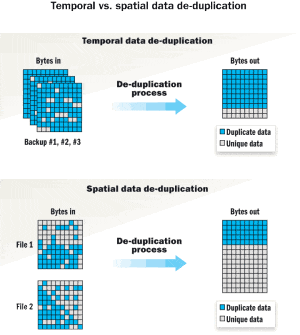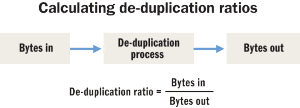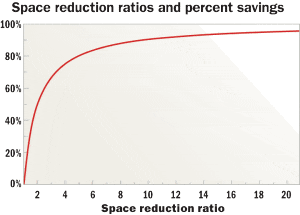Data de-duplication plays a vital role in helping to manage today’s prolific growth of data. Optimizing data storage systems with de-duplication can be part of a broader strategy to provide an efficient data storage infrastructure that is responsive to dynamic business requirements.
According to the Storage Networking Industry Association (SNIA), “Data de-duplication is defined as the process of examining a data set or byte stream at the sub-file level and storing and/or sending only unique data.” There are many different ways to perform this process, but the key factor distinguishing data de-duplication from other space reduction techniques is the reduction of duplicate data at the sub-file level.
This article explores the significance of data de-duplication space savings ratios, and provides an understanding of various claims made by vendors.
Data de-dupe ratios
Simply stated, a data de-duplication ratio refers to the number of bytes input into the de-duplication process divided by the number of bytes output from the process. The figure below depicts how data de-duplication ratios are calculated.
De-duplication savings are typically depicted as a ratio; for example, 10:1. Understanding the significance of de-duplication ratios also requires the understanding of a few basic points:
- Relatively low de-duplication ratios can yield significant space savings;
- Ratios are meaningful only when compared under the same set of assumptions;
- De-duplication ratios are influenced by many characteristics of the examined data.
Relatively low de-duplication ratios can yield significant space savings. The wide range of space reduction ratios reported by vendors can mask the value of smaller ratios. As shown in the figure below right, relatively low space reduction ratios can still yield significant savings. De-duplication savings ratios of 2:1 or 3:1 may seem unimpressive, but when placed in the context of removing 50% or 66% of physical data stored, the benefit becomes much more apparent.
Conversely, once de-duplication ratios become 10:1 or higher, the relative amount of data reduction becomes less of a factor as a percentage of overall data reduction. When claims are made of 50:1 or even 500:1 de-duplication ratios, a dose of common sense is prescribed. For example, de-duplication ratios of 50:1 and 500:1 yield an incremental 8% and 9.8% disk savings, respectively, beyond the 90% disk savings achieved with a 10:1 de-duplication ratio.
Ratios are meaningful only when compared under the same set of assumptions. Data can be generally categorized as either temporal or spatial. Temporal data accumulates over time based on recurring events; an example of this would be nightly backups. Spatial data tends to be more fixed in size, examples being data stored by primary data applications and within archived volumes.
With de-duplication of temporal data, the potential for redundant data increases as events cause the amount of data to increase over time. This may be particularly true when performing operations such as data backups. Backup data sets often contain a large amount of redundant data. In this environment, de-duplication ratios can be very high.
Spatial data de-duplication, while typically offering lower space savings ratios, still provides a valuable function by reducing redundancies across a broad spectrum of data sets and storage tiers. De-duplication ratios in these environments may be lower, but as previously mentioned still provide valuable space savings. The figure on page 33 illustrates the effect of de-duplication with temporal and spatial data.
De-duplication ratios are influenced by the characteristics of the data. The length of time that data is retained usually impacts data de-duplication ratios. As more data is accumulated, the likelihood of finding duplicate data is increased and the space savings will thus increase. This is true for both temporal and spatial data:
The wider the scope of data de-duplication, the higher the data de-duplication ratio will likely be. For instance, global de-duplication technologies are available that support de-duplication of data across multiple storage systems that may span several locations.
- The type of data can be a good indicator of how well it can be de-duplicated. For example, files created by humans often contain redundant data and are frequently distributed or copied. Examples are application data, such as documents, spreadsheets, and presentations. On the other hand, data created from non-human sources is typically random and unique. Examples include images, audio files, and scientific data acquisition. To help predict the effect of de-duplication savings on a particular data set, redundancy modeling and analysis tools are available, which reflect the level of data redun- dancy in a given environment.
- The frequency that data is changed also impacts the likelihood that duplicate data will be created. The less that data is manipulated, the greater the chance that copies of that data will contain the same data as other copies. Frequent update, copy, or append operations may also make it more difficult for some algorithms to detect duplicate data. Generally, the data de-duplication ratio will be higher when the file change rate is lower. This also implies that a higher data de-duplication ratio should be expected as the percentage of reference data to total active data increases since reference data is not changed.
- The total amount of data growth does not necessarily mean that de-duplication ratios will also rise. Growth may be due to storing new data that does not necessarily duplicate existing data. A high data growth rate may actually result in a lower data de-duplication ratio if this growth results in more unique data.
A must-have
A thoughtful deployment of data de-duplication reduces storage costs and allows data to be retained for longer periods of time on disk without excessive physical storage penalties. The economics of data de-duplication makes it more than compelling; it is becoming mandatory for any organization seeking to maximize its data management support levels.

Once an accurate calculation is made, an informed decision can be made concerning trade-offs in performance and cost when measured against the potential space savings provided through data de-duplication.


 The wider the scope of data de-duplication, the higher the data de-duplication ratio will likely be. For instance, global de-duplication technologies are available that support de-duplication of data across multiple storage systems that may span several locations.
The wider the scope of data de-duplication, the higher the data de-duplication ratio will likely be. For instance, global de-duplication technologies are available that support de-duplication of data across multiple storage systems that may span several locations.